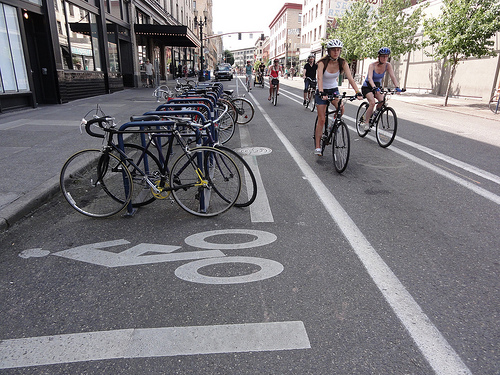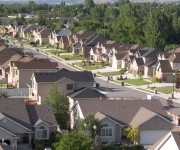 A bike corral in Portland.Photo: Greg RaismanNevada City, Calif., has got a fever — and the only cure is more bike corrals.
A bike corral in Portland.Photo: Greg RaismanNevada City, Calif., has got a fever — and the only cure is more bike corrals.
Bike corrals are like supersized bike racks in a parking spot, usually on-street, which replace one or two car parking spaces with anywhere from four to 20 bike parking staples. They’re growing in popularity around the country (I wrote about them in a Bikenomics column a few months ago), but even I was surprised that bike advocates here had read about it and gotten excited.
So at 8 a.m., with coffee and local strawberries in hand, we went for a walk around tiny, touristy downtown Nevada City with a delegation of transportation advocates, the city manager, and a traffic engineer from the next town over.
We started out in the public parking lot outside the APPLE Center, a nonprofit sustainability resource center. “I’d like to have a bike corral here,” said the center’s director, Mali Dyck, indicating the parking spot near the door. It’s a little embarrassing, she says with a laugh, to have a sustainability resource center with no bike parking.
Two in our group showed up by bike; they leaned their rides up against lamp posts on the sidewalk right outside, for lack of better options. “I’ve traveled all over the country,” said Rich Looney, the chair of the Alliance for People Powered Transportation (APPT) board, “and one thing I’ve noticed is people want to park their bikes right where they’re going.” APPT is the county’s bike advocacy organization, and they’re in the thick of figuring out how to make the county’s economy resilient in the face of rising energy costs. Tourism and agriculture are the big local industries and both are affected by the skyrocketing cost of gas.
APPT has seized on bike corrals as an affordable and politically feasible way to improve bike infrastructure and attract bicyclists along with the extra revenue that extra parking brings. But they weren’t quite sure where to start.
 The new pocket park.Photo: Elly BlueBut we learned a few minutes later that sustainability-minded Nevada City has been going full speed ahead. Two blocks away is the brand new boardwalk — which is actually a pocket park, modeled after the ones in San Francisco. It replaces an entire block of parking with a wooden deck with benches and planters. A local business owner and city councillor who spearheaded the project hosed the deck down, and told us that a bike corral should be installed right next to it any day. Tourists had been reluctant to walk down that street because of the number of people sitting on the sidewalk; so instead of kicking the sitters out, they built the park, and so far every day there’s a mix of people using it, getting along just fine. Our hosts assume we have these everywhere in Portland. When I tell them that we don’t, and that it’s very cutting edge, they’re surprised and pleased.
The new pocket park.Photo: Elly BlueBut we learned a few minutes later that sustainability-minded Nevada City has been going full speed ahead. Two blocks away is the brand new boardwalk — which is actually a pocket park, modeled after the ones in San Francisco. It replaces an entire block of parking with a wooden deck with benches and planters. A local business owner and city councillor who spearheaded the project hosed the deck down, and told us that a bike corral should be installed right next to it any day. Tourists had been reluctant to walk down that street because of the number of people sitting on the sidewalk; so instead of kicking the sitters out, they built the park, and so far every day there’s a mix of people using it, getting along just fine. Our hosts assume we have these everywhere in Portland. When I tell them that we don’t, and that it’s very cutting edge, they’re surprised and pleased.
We visited another business where the owner, we’re told, wants to replace one of her parking spaces with a bike corral. We go poke around, and the city manager explains that while it might be possible to make a variance to parking requirements so she could refit a parking spot to accommodate bikes, business owners usually don’t want to give up car parking and the revenue that comes with it.
Then the business owner came outside to explain that she wants to put a combination of bicycle and motorcycle parking in the space on the end, next to a concrete wall. It’s a safety concern, she explains — there have been several near misses with people backing their cars out of that spot and not being able to see people who are walking — in one case, a running toddler — down the street. But when she called the city about the idea, they said they couldn’t afford to lose the tax revenue from the parking space. $4,000 a year was the figure they gave her. The city manager is agreeable. “Well, just send a letter to me,” he says. “And draw up a schematic.” The owner beams. So does Looney. “How do we make this happen more often,” he asks?
As we were talking, someone on a bike rolled up — the first I’d seen all morning. It was a woman who had been at our event the night before. We waved and she waved back. Then, lacking bike parking, she carefully leaned her bike against the freshly painted exterior of the coffee shop across the street and went inside. We all started laughing. “We didn’t arrange that with her in advance,” Rich said. “I swear.”
It was a hopeful morning: Nevada City isn’t particularly bike-friendly yet, but they have all the ingredients. The challenges in this town are typical of rural areas: winding country roads with no shoulders and no room for bike lanes, lots of tourists who might not know they need to watch out on blind curves. But they have a lot going for them, too, including a growing population of dedicated daily riders, a bike-friendly city council and city manager. There’s a strong advocacy group that’s excited to find creative solutions-like bike corrals and uphill-only bike lanes, and new, young blood in the form of a bike collective in the process of forming.
Most of all, though, bicycling doesn’t seem to be politically polarized here (at least not yet, the cynical part of me wants to say). But perhaps Nevada City’s lack of any bike-friendly infrastructure means they won’t have to go through the growing pains and political drama of reinventing the wheels of broken bike infrastructure. If they succeed, they’ll really be a bike-friendly town to watch.




